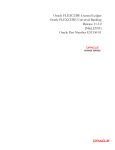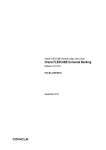Download FGL Integration - Oracle Documentation
Transcript
FGL Integration Oracle FLEXCUBE Universal Banking Release 11.3.83.02.0 [April] [2014] Oracle Part Number E53607-01 FGL Integration Table of Contents ORACLE FLEXCUBE UNIVERSAL BANKING ...................................................................................................0 RELEASE 11.3.0..........................................................................................................................................................0 1. ABOUT THIS MANUAL................................................................................................................................ 1-1 1.1 1.2 1.3 1.4 1.5 1.6 1.7 2. INTRODUCTION ........................................................................................................................................... 1-1 AUDIENCE .................................................................................................................................................. 1-1 ACRONYMS AND ABBREVIATIONS .............................................................................................................. 1-1 ORGANIZATION .......................................................................................................................................... 1-1 CONVENTIONS USED IN THIS MANUAL ....................................................................................................... 1-1 GLOSSARY OF ICONS .................................................................................................................................. 1-1 RELATED DOCUMENTS ............................................................................................................................... 1-2 ORACLE FLEXCUBE – FGL INTEGRATION.......................................................................................... 2-1 2.1 INTRODUCTION ........................................................................................................................................... 2-1 2.2 CORE MAINTENANCES................................................................................................................................ 2-1 2.3 MAINTAINING BRANCH PARAMETERS ........................................................................................................ 2-2 2.4 DATA TRANSFER FROM FGL TO ORACLE FLEXCUBE.............................................................................. 2-2 2.5 DATA TRANSFER FROM ORACLE FLEXCUBE TO FGL.............................................................................. 2-3 2.5.1 Transaction Data Handoff ................................................................................................................. 2-3 2.5.2 Customer MIS Handoff ...................................................................................................................... 2-4 2.5.3 Accounting Entries Handoff............................................................................................................... 2-5 3. SCREEN GLOSSARY .................................................................................................................................... 3-1 3.1 FUNCTION ID LIST...................................................................................................................................... 3-1 1. About this Manual 1.1 Introduction This manual is designed to help acquaint you with the integration of Oracle FLEXCUBE and Oracle FLEXCUBE General Ledger (FGL) system. This manual provides you extensive explanations about the maintenances and processing of exchange of data between Oracle FLEXCUBE and FGL. Besides this User Manual, while maintaining the details, you can invoke the context sensitive help available for each field. This help encapsulates the purpose of each field within a screen. Placing the cursor on the relevant field and striking the <F1> key on the keyboard can obtain information specific to a particular field. 1.2 Audience This manual is intended for the following User/User Roles: 1.3 1.4 Role Function Back office data entry Clerks Input functions for maintenances Back office Managers/Officers Authorization functions Acronyms and Abbreviations Abbreviation Description System Unless and otherwise specified, it shall always refer to Oracle FLEXCUBE system SDE System Data Element FGL Oracle FLEXCUBE General Ledger GL General Ledger Organization This document talks about the required maintenance and further processing of data transfer between Oracle FLEXCUBE and FGL. This includes the following: 1.5 Maintaining Bank Parameters Data Transfer from FGL to Oracle FLEXCUBE Data Transfer from Oracle FLEXCUBE to FGL Conventions Used in this Manual Important information is preceded with the 1.6 symbol. Glossary of Icons This User Manual may refer to all or some of the following icons. 1-1 Icons Function New Copy Save Delete Unlock Print Close Re-open Reverse Template Roll-over Hold Authorize Liquidate Exit Sign-off Help Add row Delete row Refer the Procedures User Manual for further details about the icons. 1.7 Related Documents You can refer to the following documents: XML Interface Document Oracle FLEXCUBE General Ledger User Manual 1-2 2. Oracle FLEXCUBE – FGL Integration 2.1 Introduction Oracle FLEXCUBE General Ledger (FGL) system is the pillar on which various functional components of Oracle FLEXCUBE rest. Through this single entity you can consolidate and maintain balances and turnovers of all types of accounts your bank holds. In addition, FGL helps you retrieve the information on the FGLs maintained for your bank. FGL is a standalone general ledger system with the ability to define chart of accounts. You may also use this system to keep a complete track of the ledger balances of your organization. FGL interacts with external systems including Oracle FLEXCUBE through web services. This enables transfer of information pertaining to transactions, general ledgers, MIS and accounting entries between these systems. Data transfer between Oracle FLEXCUBE and FGL are facilitated by two jobs: FGL Extraction Job – Extracts data from FGL FGL Handoff Job – Hands off data to FGL This document guides you through the maintenances and processes required for data transfer between Oracle FLEXCUBE and FGL. 2.2 Core Maintenances The following core maintenance should be in sync with Oracle FLEXCUBE for the FGL Integration: Bank Parameters Branch Parameters Financial Cycles Accounting Periods Transaction Codes Currency Details Currency Position Details MIS Maintenance Chart of Accounts Refer to Oracle FLEXCUBE General Ledger User Manual for details on maintenances related to FGL. 2-1 2.3 Maintaining Branch Parameters To enable data transfer between Oracle FLEXCUBE and Oracle FLEXCUBE General Ledger, you need to set certain options at bank parameter level. FGL Handoff Required Check this option to indicate that FGL handoff is required for the bank. The system will enable data transfer between Oracle FLEXCUBE and FGL only you check this option. 2.4 Data Transfer from FGL to Oracle FLEXCUBE FGL extracts information pertaining to general ledger and MIS for Oracle FLEXCUBE. This extraction happens whenever one of the following operations happens in FGL: Creation of GL Closure of GL Reopening of GL Creation of MIS Class Modification of MIS Class Additionally, Oracle FLEXCUBE extracts the following maintenances from FGL: SDE Definition General Ledger Information MIS Maintenance MIS Classes MIS Codes 2-2 The extracted data gets uploaded into the system. The process of data transfer between Oracle FLEXCUBE and FGL takes place during intraday batch process. The transfer will be completed before end of day operations begin. The FGL data discussed above is a subset of what is required for Oracle FLEXCUBE. Hence the extracted data needs to be enriched. 2.5 Data Transfer from Oracle FLEXCUBE to FGL Oracle FLEXCUBE hands off the following information to FGL: Transaction Data Accounting Entries Customer MIS Information FGL handoff job extracts the above data from Oracle FLEXCUBE and uploads them into FGL. 2.5.1 Transaction Data Handoff When a new transaction is created or an existing transaction is modified, the system hands off the updated transaction data to FGL. FGL stores the received transaction data as ‘Transaction Objects’. Transaction data handoff will be triggered when the first accounting entry from a transaction comes for authorization in Oracle FLEXCUBE. Based on the module of the transaction, the system uses appropriate extractor packages and converts the data into record format, which is recognized by FGL. The system extracts all possible transaction attributes that can be used as SDEs and converts them into record format for handoff. The number and nature of the transaction data extracted from each module will be different. For example, an FT contract may have 20 attributes, where as a retail lending account may have 30-40 attributes. However, FGL receives a maximum of 30 transaction attributes irrespective of the module. Along with the accounting entries, Oracle FLEXCUBE sends the transaction object reference number generated by FGL for identification. Changes in transaction MIS information (transaction and composite MIS codes) will be handed off to FGL along with the other transaction information. 2-3 2.5.1.1 Mapping Transaction Attributes to SDEs Transaction attributes extracted from Oracle FLEXCUBE needs to be mapped to a corresponding SDE in FGL. User defined fields at the contract level can also be mapped to SDEs. You can maintain this mapping using ‘SDE Mapping’ screen. To invoke the screen, type ‘IFDSDMAP’ in the field at the top right corner of the Application toolbar and click the adjoining arrow button. You can capture the following details on this screen: Module Code Specify the module code. You can map the attributes of transactions entered in this module to corresponding SDE from this screen. Module Description The system displays the description of the module. SDE Code Specify the SDE code to be mapped to the transaction attribute. Module Transaction Attributes Specify the transaction attribute to be mapped to the selected SDE. Depending on the SDE definition and mapping, the transaction attributes handed off from Oracle FLEXCUBE will be mapped to the corresponding attribute in FGL. 2.5.2 Customer MIS Handoff When there is a change in customer MIS information in Oracle FLEXCUBE, the details are handed off to FGL. On customer authorization, the system will identify the MIS change and initiate the handoff process. 2-4 2.5.3 Accounting Entries Handoff During authorization, after the transaction data handoff, the system will begin handoff of accounting entries. Accounting entries will be handed off in record format with ‘AC_ENTRY_SR_NO’ in the beginning and end of the record. For entries into customer accounts, system updates the credit and debit GLs along with the current balance of the customer account. This is handed off to FGL as an accounting entry pair. FGL resolves and passes the accounting entries accordingly. Oracle FLEXCUBE does not handoff revaluation, position and IB entries to FGL. These are resolved in FGL itself. 2-5 3. Screen Glossary 3.1 Function ID List The following table lists the function id and the function description of the screens covered as part of this User Manual. Function ID Function Description IFDSDMAP SDE Mapping Detailed 3-1 FGL Integration [April] [2014] Version 11.3.83.02.0 Oracle Financial Services Software Limited Oracle Park Off Western Express Highway Goregaon (East) Mumbai, Maharashtra 400 063 India Worldwide Inquiries: Phone: +91 22 6718 3000 Fax:+91 22 6718 3001 www.oracle.com/financialservices/ Copyright © 2005, 2014, Oracle and/or its affiliates. All rights reserved. Oracle and Java are registered trademarks of Oracle and/or its affiliates. Other names may be trademarks of their respective owners. U.S. GOVERNMENT END USERS: Oracle programs, including any operating system, integrated software, any programs installed on the hardware, and/or documentation, delivered to U.S. Government end users are ‘commercial computer software’ pursuant to the applicable Federal Acquisition Regulation and agency-specific supplemental regulations. As such, use, duplication, disclosure, modification, and adaptation of the programs, including any operating system, integrated software, any programs installed on the hardware, and/or documentation, shall be subject to license terms and license restrictions applicable to the programs. No other rights are granted to the U.S. Government. This software or hardware is developed for general use in a variety of information management applications. It is not developed or intended for use in any inherently dangerous applications, including applications that may create a risk of personal injury. If you use this software or hardware in dangerous applications, then you shall be responsible to take all appropriate failsafe, backup, redundancy, and other measures to ensure its safe use. Oracle Corporation and its affiliates disclaim any liability for any damages caused by use of this software or hardware in dangerous applications. This software and related documentation are provided under a license agreement containing restrictions on use and disclosure and are protected by intellectual property laws. Except as expressly permitted in your license agreement or allowed by law, you may not use, copy, reproduce, translate, broadcast, modify, license, transmit, distribute, exhibit, perform, publish or display any part, in any form, or by any means. Reverse engineering, disassembly, or decompilation of this software, unless required by law for interoperability, is prohibited. The information contained herein is subject to change without notice and is not warranted to be error-free. If you find any errors, please report them to us in writing. This software or hardware and documentation may provide access to or information on content, products and services from third parties. Oracle Corporation and its affiliates are not responsible for and expressly disclaim all warranties of any kind with respect to third-party content, products, and services. Oracle Corporation and its affiliates will not be responsible for any loss, costs, or damages incurred due to your access to or use of third-party content, products, or services.
























